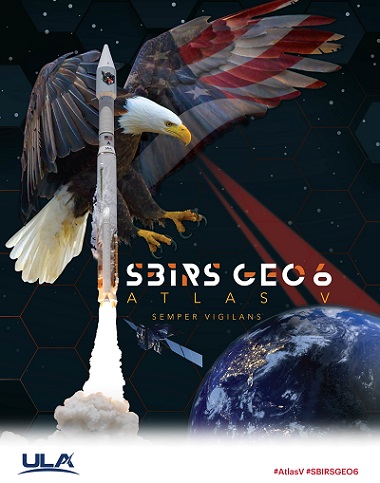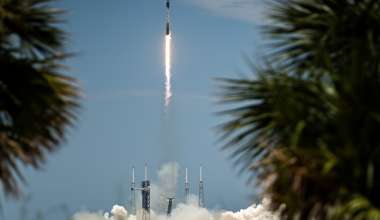Thirty-four days after the last National Security Space Launch (NSSL), a United Launch Alliance (ULA) Atlas V launch vehicle lifted off from Space Launch Complex 41 on Aug. 4 and successfully delivered the sixth and final Space Based Infrared System Geosynchronous Earth Orbiting (SBIRS GEO) satellite to geosynchronous transfer orbit (GTO) for the United States Space Force (USSF) Space Systems Command (SSC).

The SBIRS GEO-6 mission used an Atlas V 421 rocket, which includes the bisector (two-piece shell) four-meter diameter extra extended payload fairing (XEPF), two strap-on solid rocket graphite epoxy motors (GEMs) and a single Aerojet Rocketdyne RL10C-1 engine Centaur upper stage. The SBIRS GEO-6 mission was completed in a little under four hours.
As with prior NSSL missions, The Aerospace Corporation conducted independent analyses and evaluations of the flight systems, working with USSF to augment ULA’s mission assurance process to ensure the continued NSSL program’s legacy of 100 percent mission success. Special attention was placed on first flight hardware items implemented for performance improvements and cost efficiencies.
Even though the SBIRS GEO-5 and SBIRS GEO-6 spacecraft are nearly identical, learning from the SBIRS GEO-5 mission was applied to the SBIRS GEO-6 mission to optimize the injection orbit, thereby significantly extending the SBIRS GEO-6 spacecraft’s predicted lifetime on orbit and increasing resiliency. The launch marked the 95th successful launch of an Atlas V rocket, the 152nd launch for ULA, the ninth 421 configuration vehicle and the third Atlas V NSSL mission of 2022.
The launch marked the 95th successful launch of an Atlas V rocket, the 152nd launch for ULA, the ninth 421 configuration vehicle and the third Atlas V National Security Space Launch (NSSL) mission of 2022.
SBIRS is a high-priority USSF program that provides space-enabled capabilities to support U.S. military systems and consists of a constellation of satellites in both GEO and highly elliptical orbit (HEO).

The SBIRS GEO-6 satellite, like the SBIRS GEO-5 satellite, is built on Lockheed Martin’s modernized LM2100 Combat Bus, which provides enhanced resiliency and cyber-hardening against growing threats, as well as improved spacecraft power, propulsion and electronics. The SBIRS constellation of missile warning satellites is equipped with powerful scanning and staring infrared surveillance sensors that continually protect the nation.
“My sincere thanks to our SSC and Aerospace teammates on the success of another Atlas V launch,” said John Steinmeyer, Mission Director for the Atlas V SBIRS GEO-6 mission and Executive Director of Assured Access to Space at the Space Force’s Space Systems Command (SSC). “This SBIRS GEO-6 mission supplements and completes the current constellation of missile warning and battlespace awareness sensing capabilities, which continues to strengthen our nation’s warfighters. The relatively smooth campaign and count, and few launch observations are a testament to the effectiveness of our team. The long-standing partnership between the Space Force and Aerospace are what make missions like these a success!”
The next Atlas V US Space Force National Security Launch mission is expected to be in the second quarter of 2023.






